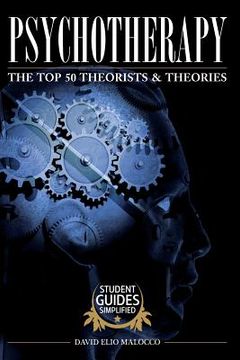Reseña del libro "Psychotherapy: The Top 50 Theorists and Theories (en Inglés)"
This book by best selling author David Elio Malocco (Forensic Science: Crime Scene Analysis and Criminal Profiling: An Introduction) is aimed primarily at those interested in entering the world of mental health but basically it will be enjoyed by anyone with an interest in Psychology. The book lists the world's top psychiatrists, psychoanalysts, psychologists and psychotherapists from Sigmund Freud to the present day.Those covered in the book include Freud (Sigmund and Anna), Adler, Thorndike, Jung, Watson, Klein, Deutsch, Rank, Horney, Fairbairn, Moreno, Sullivan, Perls, Winnicott, Bion, Mahler, Foulkes, Fromm, Erickson, Rogers, Skinner, Maslow, Berne, Ellis, Kohut, Bruner, Bugental, Eysenck, Satir, Milner, Bowen, Beck, Minuchin, Bandura, Glasser, Laing, Yalom, Kim berg, Meichenbaum, Gottman, Seligman, Linehan, Kabat-Zinn, Teasdale, Shapiro, Strasahl, Segal, and Fredrickson.The book not only covers a biography of each theorist but a simplified yet reasonably detailed account and analysis of their theories and how they inter-relate with previous influencers. In this regard the entries are made in a chronological order so the reader can appreciate how theories have developed over the years.Those interested in entering therapy either as client or therapist should note that the three main approaches of psychology are covered: Psychodynamic, Humanistic and Behavioural. The Psychodynamic approach, including psychoanalytic, is the oldest with an emphasis on bringing the unconscious into consciousness so gaining greater self-knowledge. It is usually long-term work, often over a number of years, and in the case of psychoanalysis with several sessions each week. It delves into the past to discover the origins of our behavioural patterns and belief systems. The therapists are relatively silent, and refer to their clients as patients. The chief proponents are Freud, Jung and Klein.The Humanistic approach includes Person-Centred, Gestalt, TA (Transactional Analysis), Existential and Integrative. The Humanistic approach sits between the Psychodynamic and Behavioural approaches and can embrace elements of both. This model tends to be shorter term than Psychodynamic, but tends to be longer than the brevity of CBT. Therapists usually have a more interactive and equal relationship with their clients than psychodynamic therapists, and less of the purely teaching relationship of a CBT practitioner.Although Humanistic therapists consider it important to look at past experiences, the main thrust is to help a client feel sufficiently empowered so that they can take better control of their life. The key names here are Rogers, Berne and Perls.The Behavioural approach covers CBT (Cognitive-Behavioural Therapy) and REBT (Rational-Emotive Behaviour Therapy). These approaches are the youngest of the three and are different from the first two in that they focus on the here and now and do not investigate the causes. It is brief therapy with the aim of helping clients unlearn their negative and unhelpful reactions to situations and learn new ways of reacting.Understanding how a client came by their belief system is not considered and consequently the longerterm effectiveness of CBT has yet to be examined. Research does show that CBT can produce very effective benefits in the short term. The book discusses Skinner, Beck, Ellis and Eysenck and several others.This is the first book in a series entitled Student Guides Simplified.

